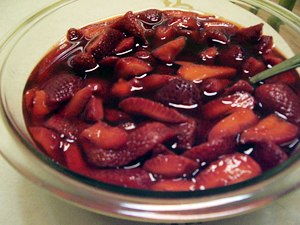But with less sugar and no added pectin, won't your jam be a runny mess? Nope! There's an easy, just about foolproof way to get good jam every time, and all you need is sugar, lemon juice, and time.
 Take a look at this bowl.
Take a look at this bowl.
That's 4 pints of strawberries, sliced, mixed with sugar and left to sit overnight until they've shrunken into little berry quarters bobbing in a sea of juice. All that liquid was originally trapped in the berries themselves, and you'd be boiling it mightily for a long time if you just threw the fruit and sugar together and tossed them on the stove.
But separate the liquid from the fruit, add a little lemon juice (which is rich in pectin), and--here's the trick-- cook down the liquid, not the fruit. By cooking the liquid by itself first, you can evaporate any excess water without exhausting the fruit's delicate flavors. There's also less risk of burning and sticking when you're just simmering juice.
This is a technique I first picked up from Helen Witty's invaluable, library-available collection, The Good Stuff Cookbook. In my copy, the jam chapter is wrinkled and spattered on every page, with annotations, additions, and comments in pen and pencil from years of messing around. I use a lot less sugar than Witty does, but her method (streamlined here) still works like a charm to produce delicious jams just thick enough to cling to your biscuit, redolent of ripe, sunwarmed summer fruit.
Since strawberries are ripe and wonderful this week, now's the time to grab a case of jars, a flat of fruit, and get your birthday-and-holiday gifts nailed down. I love Albion berries in particular, but Seascapes, Tristars and Chandlers, all varieties that do well in our cool coastal climate, won't do you wrong, either.
If you want your sealed jars to be able to sit around in the pantry, you need real canning jars topped with two-part lids. Otherwise, if you're just going to stick your jam in the fridge immediately and eat it soon, you can reuse any clean, cute glass jar you have. For best results, sterilize any jar in a boiling-water bath for 10 minutes before using.
Strawberry Jam
Ingredients:
4 pint boxes whole strawberries (2 1/2 lbs)
1 1/2-2 cups granulated sugar, depending on sweetness of berries
juice of 1 lemon, about 2 tablespoons
Preparation:
1. Rinse, drain, and hull strawberries. Slice in halves or quarters. In a nonreactive bowl, toss berries with sugar and lemon juice. Cover and let stand for 3-4 hours at room temperature or 6 hours to overnight in the refrigerator. Stir occasionally, scraping the bottom of the bowl to distribute and dissolve the sugar.
2. When sugar is dissolved and berries are floating in a bright-red syrup, pour into a large nonreactive pot. Bring to a frothy simmer, stirring frequently. Let simmer for 2 minutes, then pour back into bowl. Let cool. Cover and let stand for 2-3 hours at room temperature, or in the refrigerator for 6 hours or overnight.
3. Meanwhile, sterilize your jars, lids, and rings. Set a colander or strainer over a wide, large, and heavy stainless steel or enameled cast-iron pot. Pour berries into colander, letting all the syrup drip into the pot. Remove colander full of berries and set aside.
4. Bring syrup to a boil over medium heat, stirring frequently. Once syrup comes to a boil, stir and watch: it will move from what looks like a pot full of Kool-Aid to a seething, deep-garnet mass of thick, glossy bubbles. Dip a metal spoon into the syrup and let syrup drip off the side of the spoon; it's ready when the last few drops are fairly thick and sticky.
5. Pour in reserved berries. Bring to a boil, stirring constantly. If you'd like a thicker jam, mash berries lightly with a potato masher. Simmer for 5-8 minutes, until berries are translucent and mixture has thickened slightly. Scoop into jars and seal.
 Take a look at this bowl.
Take a look at this bowl.